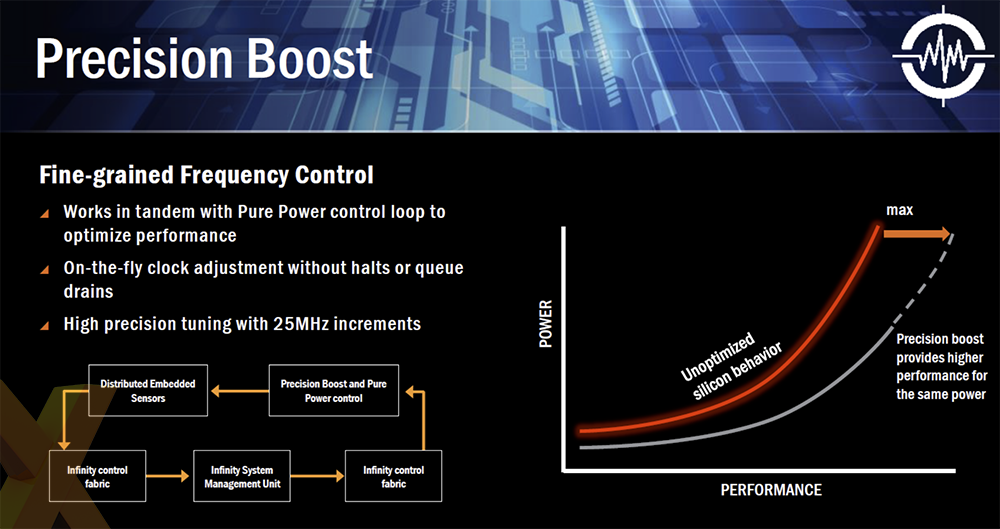Other Goodies
We now know more of the architectural underpinnings of Zen, and Ryzen by intimation. AMD appreciates that it needs to get within the ballpark of current Intel performance for it to be considered a worthy alternative, so maximising the potential of the architecture is a must.
Getting the most out of the chips is a trio of technologies called Precision Boost, Pure Power and XFR, and packaged under the umbrella marketing term SenseMI (Machine Intelligence). Let's cover each in turn and see how they positively impact upon performance.
Ryzen has almost 1,000 sensors distributed across the design. Their job is to provide fine-grained details on amperage, voltage, wattage and temperature. Polling at up to 1,000 times a second and millwatt-, milliamp-, millivolt-, and degree-accurate, the information is fed into the aforementioned Infinity Fabric and control logic. This logic, under the auspice of Precision Boost, then modulates various facets of Ryzen performance to eke out the best from the processor. What's interesting is that, like graphics, this works on a per-chip basis, meaning that each processor will run differently due to silicon and temperature variations.
What this means is that the operating system effectively hands over to the control logic which then decides how best to run the processor. AMD is deliberately pushing close to the curve on all fronts, through enhanced reporting, hoping to maximise performance and efficiency.
Precision Boost is able to set the CPU's frequency in 25MHz increments, rather than the 100MHz we see when using the multiplier alone. It's worth reiterating that CPU frequency optimisations are becoming far more like a GPU, and Zen is able to move up and down the frequency ladder seamlessly. Point is, the chip should be boosting at all times, switching between frequencies faster than you can detect, with the aim of achieving the highest clock speeds possible. In terms of curves, SenseMI seeks to shift the frequency/voltage curve upwards, tapping into each chip's potential.
It is for this reason why you won't see any per-core boost speeds listed for these processors; each chip will be doing the 'best it can' in any given frequency/voltage/thermal environment.
SensiMI, as you may have guessed, is a fully automated system that runs oblivious to the user. Given how improved cooling will change the way in which SenseMI implements frequency, with the potential to go higher if there is sufficient headroom on the various characteristics to do so, Ryzen has an additional, automated mode called eXtended Frequency Range (XFR).
This mode, active when SenseMI spies improved cooling - high-end air, watercooling, etc. - enables Ryzen to boost to a higher-than-normal frequency state. The exact amount of headroom depends upon chip and quality of cooling, but we expect to see another 100MHz available, stepped up in the granular 25MHz increments.
There's no hard-and-fast rule about which cooling is good enough to activate XFR, though a sensible assumption is that premium cooling ought to herald frequency uptick. You can think of XFR as being analogous to the actual frequency of a modern GPU - it's a silicon lottery, with much resting on the cooler and ambient temperature.
Of course, users wanting to push their Ryzen chips further can manually overclock using old-fashioned BIOS or a Windows-based Ryzen Master (Overclocking) Utility. SenseMI is turned off as soon as the processor is removed from the auto setting in the BIOS, leaving frequency to the user's skill and judgement.












